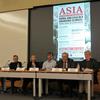Atmospheric Modeling
2024
Jul
25
New HCP Publications
Summer/Fall 2021 Newsletter
. 2021. “Global modeling of heterogeneous hydroxymethanesulfonate chemistry.” Atmospheric Chemistry and Physics, 21, 1, Pp. 457–481. Publisher's VersionAbstract
. 2020. “Health benefits of on-road transportation pollution control programs in China.” Proceedings of the National Academy of Sciences, 117, 41, Pp. 25370-25377. Publisher's VersionAbstract
. 2019. “Thermodynamic modeling suggests declines in water uptake and acidity of inorganic aerosols in Beijing winter haze events during 2014/2015–2018/2019.” Environmental Science & Technology Letters, 6, 12, Pp. 752-760. Publisher's VersionAbstract
. 2019. “Possible heterogeneous hydroxymethanesulfonate (HMS) chemistry in northern China winter haze and implications for rapid sulfate formation.” Atmospheric Chemistry and Physics, 19, Pp. 1357-1371. Publisher's VersionAbstract
. 2019. “China’s CO2 peak before 2030 implied from diverse characteristics and growth of cities.” Nature Sustainability, 2, Pp. 748–754. Publisher's VersionAbstract
Wang et al. is the cover article of this issue of Nature Sustainability.
. 2019. “The influence of dynamics and emissions changes on China’s wintertime haze.” Journal of Applied Meteorology and Climatology, 58, 7, Pp. 1603-1611. Publisher's VersionAbstract
. 2019. “Benefits of current and future policies on emissions of China's coal-fired power sector indicated by continuous emission monitoring.” Environmental Pollution, 251, August, Pp. 415-424. Publisher's VersionAbstract
China and Asia in a Changing Climate
2019
Mar
07
2019
Feb
14
. 2019. “Bottom-up estimates of coal mine methane emissions in China: A gridded inventory, emission factors, and trends.” Environmental Science and Technology Letters, 6, 8, Pp. 473-478. Publisher's VersionAbstract
. 2019. “Enhanced growth after extreme wetness compensates for post-drought carbon loss in dry forests.” Nature Communications, 10, 195. Publisher's VersionAbstract




